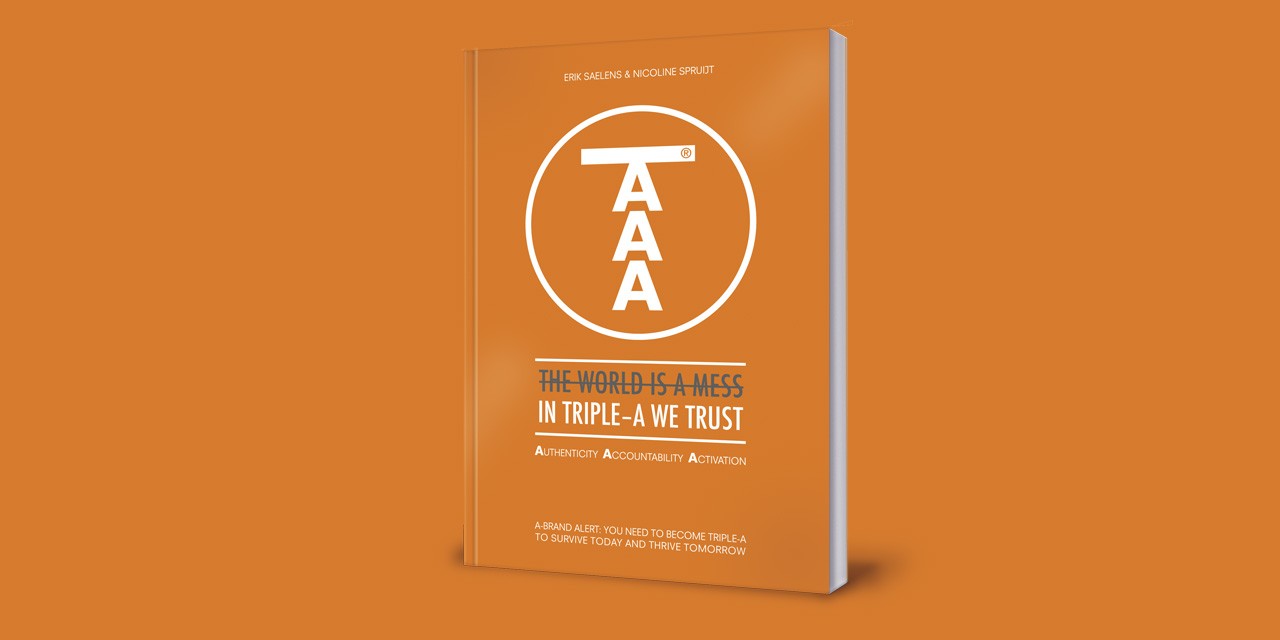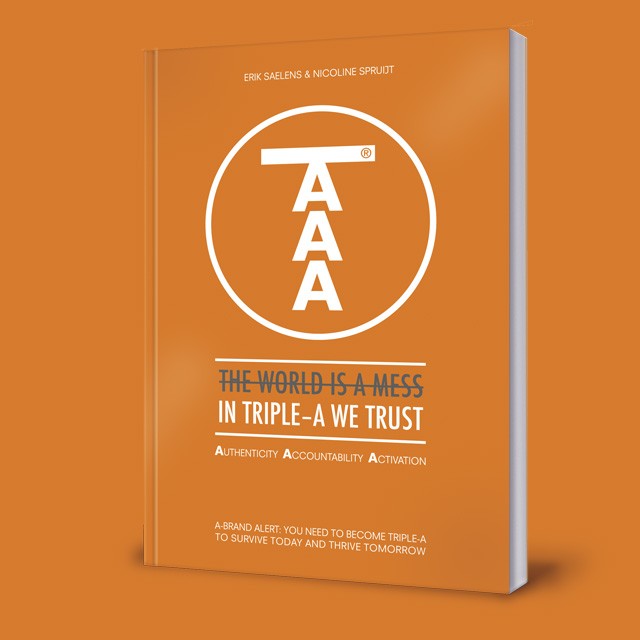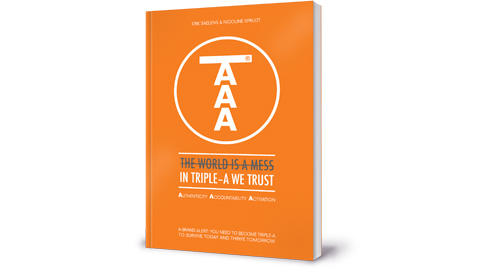

Triple-A power
In late 2012, Erik Saelens and Nicoline Spruijt launched their newest book: “The world is a mess. In Triple-A we trust”. Purchasing your own copy and reading it from cover to cover is still the best option. But if for some reason you haven’t gotten around to that yet, we’ll be happy to give you the Cliff notes, focusing on the three major pillars all future brands will count on for support in a world that’s becoming increasingly unsteady. This is the power of Triple-A.

Triple-WhAt?
Triple-A stands for: Authenticity, Accountability and Activation. Brands that want to stay strong and grow even stronger will need the full trinity. It is not enough to excel in one out of three A’s. If a brand is e.g. very Authentic but lacks Accountability and/or Activation, this will disrupt the Triple-A balance.
Are you for reAl?
Let’s start with ´Authenticity´: brands need to be authentic, or ‘real’. The developments in e.g. social media have made brands more ‘visible’ for the consumer. If your brands uses it communication to pretend to be something it’s not, you will be held accountable for it. Knowing who you are as a brand is more important than ever. Brands need to take a more ‘identity driven’ approach: once you know what you are as a brand, you are able to act accordingly.
An example of a brand treading the ‘Authenticity’ danger zone is Unilever. The large brand portfolio of this parent brand holds several brands that could cause conflicts. On the one hand, Unilever acts against sexism with ‘Dove’ by promoting ‘real beauty’. On the other hand, AXE, another Unilever brand is going in the opposite direction: if you use AXE, a bevvy of long-legged, slim-waisted beauties will throw themselves at you wherever you go. Now that Unilever is becoming more prominent as a parent brand (their new logo is an example of this new role), it could run into trouble.

Brands that do get high scores when it comes to Authenticity are Swiss pocket knives or Belgian cheeses. They exude an aura of tradition and believability. Douwe Egberts is another good example. The tagline ‘it smells like Douwe Egberts in here’ immediately evokes images of freshly ground and masterfully roasted coffee beans. The brand Douwe Egberts acts like its image of cosiness and honesty. Each year, they donate cups of coffee to the less fortunate in our society. They also contribute to a more durable coffee industry.
CAn I count on you?
The second pillar Triple-A brands count on for support is ´Accountability´. Brands that are able to achieve ‘Accountability’ are brands that are reliable. In other words: they do as they say. They don’t just talk the talk; they walk the walk. And this goes for their stance towards consumers as well as towards other stakeholders. Because brands are becoming more ‘visible’ and are being discussed on a wider scale, proving your reliability is becoming more and more crucial.
One example of a brand that turned out to be less accountable than people thought is Facebook. The stock market launch of the company was a much-anticipated event, but it turned out to be a dud. The stock kept falling, leaving shareholders to feel betrayed by the brand. Facebook’s image, which up to that point had seemed unshakable, took a big hit. And it wasn’t just the shareholders that were left wanting. Facebook’s privacy policy has come under heavy scrutiny, allowing for several hoaxes to pop up that further damaged the brand by creating an image tainted with unreliability.

A brand that succeeds in being perceived as accountable is Ryanair. This is a brand that leaves no doubt about what you can expect: a cheap flight, no frills. And that’s exactly what they deliver to the consumer. The shareholders can also count on Ryanair as a brand. The company’s profits were up by 25% in 2011, facing a climate in which many airline brands were struggling to survive.
CAn you mAke me buy?
The final pillar is ´Activation´. Brands need to be sales-driven. However, they can no longer just send out a message into the world, hoping the target audience will like them and maybe eventually even buy something. The relationship between brand and consumer has become a two-way street. A brand ‘speaks to’ its target group. But that target audience is now also talking back! An ‘activating’ brand will start up a dialogue with its consumers. It will enter their world and also try to involve the consumer into the brand world. Activation is about sales by creating brand experiences.
A fine example of ‘Activation’ can be found in the ´Jones Soda´ brand, which asked consumers to send in their personal pictures. These pictures were printed unto a limited edition series of soda bottles the consumers could order themselves. The ‘best of’ these pictures were printed on the regular bottles as well. Jones Soda was able to set up a co-production with its consumers, thus actively involving them in the Jones Soda brand world.

A true champion of Activation is Red Bull. This brand succeeds in constantly engaging people by supporting extreme sports and record attempts. This allows them to stand out from the masses and win the hearts of the consumer.
A + A + A = Triple-A
Excelling in one of the ‘A’ categories is no mean feat in itself, but it is not enough. To be able to grow as a ‘Triple-A brand’, each of the ‘A’s needs to be applied and balanced out. So now you’re asking: ‘How?’ The answer to that question is not included in this short tour of Triple-A, I’m afraid. Time to activate you as a consumer and not just as a reader. Please visit www.tripleabrands.com and order your own copy of ´In Triple-A We Trust´. All profits of the book go directly to SPARK, a communication tool for children diagnosed with autism spectrum syndrome, supported by the Brandhome foundation.
Thank you!


